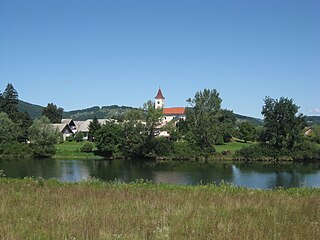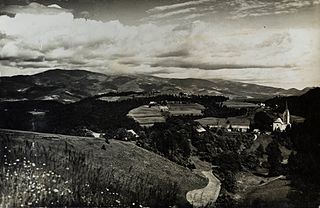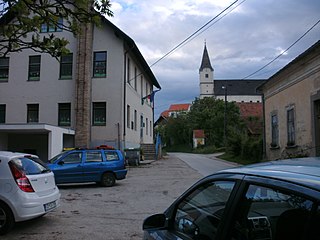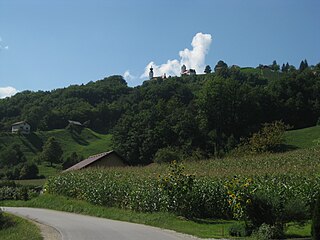| Koritno | |
|---|---|
| Coordinates: 46°24′4.51″N15°26′8.44″E / 46.4012528°N 15.4356778°E Coordinates: 46°24′4.51″N15°26′8.44″E / 46.4012528°N 15.4356778°E | |
| Country | |
| Traditional region | Styria |
| Statistical region | Drava |
| Municipality | Oplotnica |
| Area | |
| • Total | 3.8 km2 (1.5 sq mi) |
| Elevation | 651.3 m (2,136.8 ft) |
| Population (2002) | |
| • Total | 192 |
| [1] | |
Koritno (pronounced [kɔˈɾiːtnɔ] ) is a settlement in the Municipality of Oplotnica in eastern Slovenia. It is dispersed on the southern slopes of the Pohorje range to the north of Oplotnica. The area is part of the traditional region of Styria. The municipality is now included in the Drava Statistical Region. [2]

Oplotnica is a small town and municipality in eastern Slovenia. It lies on the Oplotniščica River, a left tributary of the Dravinja River, to the north of Slovenske Konjice. The area was part of the traditional region of Styria and formerly part of Austria-Hungary. The municipality is now included in the Drava Statistical Region.

Slovenia, officially the Republic of Slovenia, is a sovereign state located in southern Central Europe at a crossroads of important European cultural and trade routes. It is bordered by Italy to the west, Austria to the north, Hungary to the northeast, Croatia to the southeast, and the Adriatic Sea to the southwest. It covers 20,273 square kilometers (7,827 sq mi) and has a population of 2.07 million. One of the successor states of the former Yugoslavia, Slovenia is a parliamentary republic and a member of the United Nations, of the European Union, and of NATO. The capital and largest city is Ljubljana.
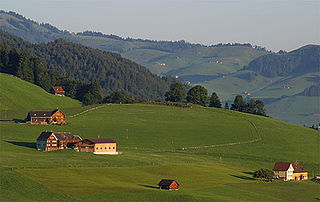
A dispersed settlement, also known as a scattered settlement, is one of the main types of settlement patterns used by landscape historians to classify rural settlements found in England and other parts of the world. Typically, there are a number of separate farmsteads scattered throughout the area. A dispersed settlement contrasts with a nucleated village.
There are two churches in the settlement. The church dedicated to Saint Nicholas dates to the 14th century and belongs to the Parish of Čadram–Oplotnica. The second church is dedicated to Saint Leonard and belongs to the Kebelj parish. It dates to the early 15th century with a 17th-century belfry. [3]

A church building or church house, often simply called a church, is a building used for Christian religious activities, particularly for Christian worship services. The term is often used by Christians to refer to the physical buildings where they worship, but it is sometimes used to refer to buildings of other religions. In traditional Christian architecture, the church is often arranged in the shape of a Christian cross. When viewed from plan view the longest part of a cross is represented by the aisle and the junction of the cross is located at the altar area.

Saint Nicholas of Myra, also known as Nicholas of Bari, was an early Christian bishop of the ancient Greek maritime city of Myra in Asia Minor during the time of the Roman Empire. He is revered by many Christians as a saint. Because of the many miracles attributed to his intercession, he is also known as Nicholas the Wonderworker. Saint Nicholas is the patron saint of sailors, merchants, archers, repentant thieves, children, brewers, pawnbrokers, and students in various cities and countries around Europe. His reputation evolved among the faithful, as was common for early Christian saints, and his legendary habit of secret gift-giving gave rise to the traditional model of Santa Claus through Sinterklaas.

Leonard of Noblac, is a Frankish saint closely associated with the town and abbey of Saint-Léonard-de-Noblat, in Haute-Vienne, in the Limousin (region) of France.



